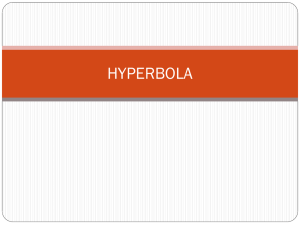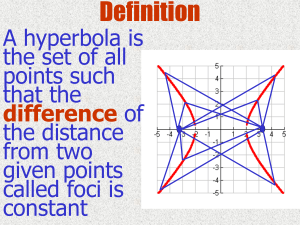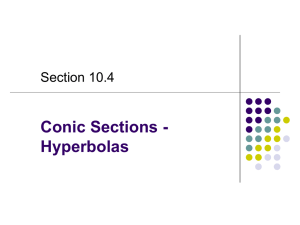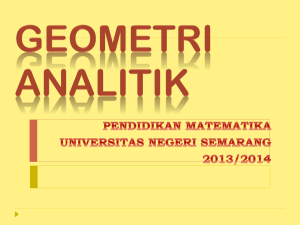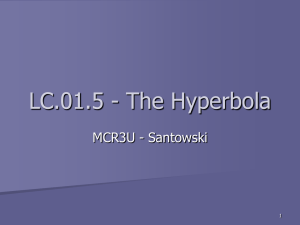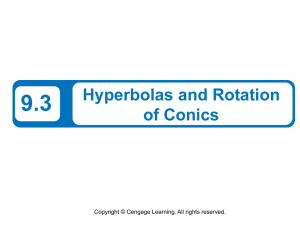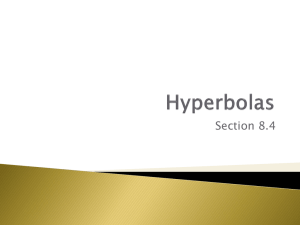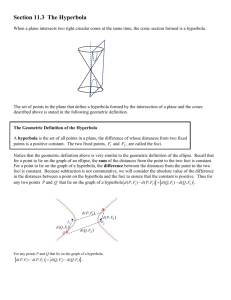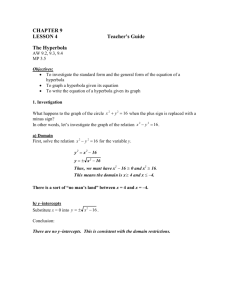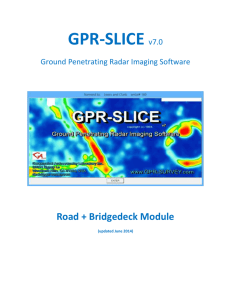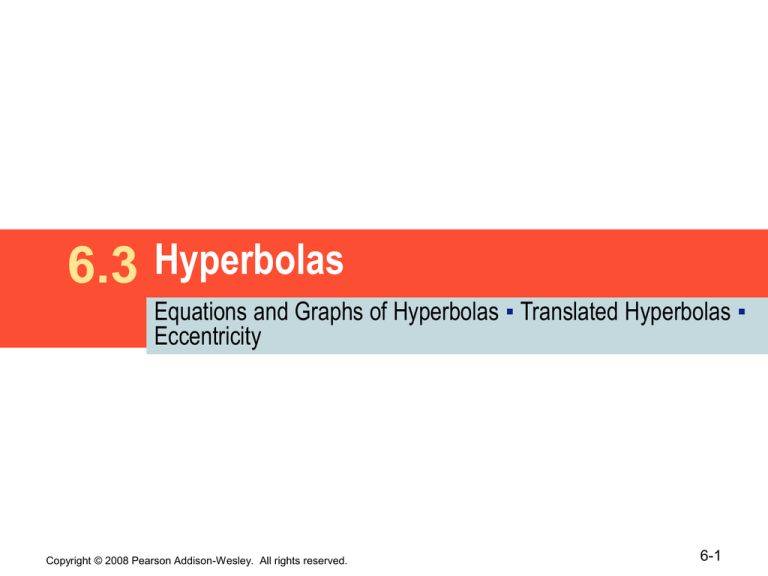
6.3 Hyperbolas
Equations and Graphs of Hyperbolas ▪ Translated Hyperbolas ▪
Eccentricity
Copyright © 2008 Pearson Addison-Wesley. All rights reserved.
6-1
6.3
Example 1 Using Asymptotes to Graph a Hyperbola
(page 628)
Give the domain and range.
The equation is of the form
, so it is centered
at (0, 0) and has branches opening to the left and right.
The vertices of the hyperbola are (2, 0) and (–2, 0) since
a = 2.
The equations of the asymptotes are
If x = 2, then y = ±5. If x = –2, then y = ±5. The corners of
the fundamental rectangle are (2, 5), (–2, 5), (–2, –5), and
(2, –5).
Copyright © 2008 Pearson Addison-Wesley. All rights reserved.
6-2
6.3
Example 1 Using Asymptotes to Graph a Hyperbola
(cont.)
Find the foci:
The foci are
Copyright © 2008 Pearson Addison-Wesley. All rights reserved.
6-3
6.3
Example 1 Using Asymptotes to Graph a Hyperbola
(cont.)
Graphing calculator solution
Solve
for y:
The union of the two graphs
is the graph of
Copyright © 2008 Pearson Addison-Wesley. All rights reserved.
.
6-4
6.3
Example 2 Graphing a Hyperbola (page 630)
Graph 16y2 – 25x2 = 400. Give the domain and range.
Divide both sides of the equation by 400 to obtain
The equation is of the form
, so it is centered at
(0, 0) and has branches opening upward and downward.
The vertices of the hyperbola are (0, 5) and (0, –5) since
a = 5.
The equations of the asymptotes are
Copyright © 2008 Pearson Addison-Wesley. All rights reserved.
6-5
6.3
Example 2 Graphing a Hyperbola (cont.)
The corners of the fundamental rectangle are (–4, 5),
(4, 5), (4, –5), and (–4, –5).
Find the foci:
The foci are
Copyright © 2008 Pearson Addison-Wesley. All rights reserved.
6-6
6.3
Example 2 Graphing a Hyperbola (cont.)
Copyright © 2008 Pearson Addison-Wesley. All rights reserved.
6-7
6.3
Example 3 Graphing a Hyperbola Translated Away From
the Origin (page 631)
Give the domain and
range.
The equation is of the form
where
h = 2, k = –4, a = 4, and b = 1. The graph opens to the
right and left.
The vertices are 4 units left and right of the center (2, –4)
at (6, –4) and (–2, –4).
The equations of the asymptotes are
Copyright © 2008 Pearson Addison-Wesley. All rights reserved.
6-8
6.3
Example 3 Graphing a Hyperbola Translated Away From
the Origin (cont.)
The corners of the fundamental rectangle are (6, –3),
(6, –5), (–2, –3), and (–2, –5).
Find the foci:
The foci are
units left and right of the center at
Copyright © 2008 Pearson Addison-Wesley. All rights reserved.
6-9
6.3
Example 3 Graphing a Hyperbola Translated Away From
the Origin (cont.)
Copyright © 2008 Pearson Addison-Wesley. All rights reserved.
6-10
6.3
Example 4 Finding Eccentricity from the Equation of a
Hyperbola (page 632)
Find the eccentricity of the hyperbola
a2 = 100, so a = 10.
Copyright © 2008 Pearson Addison-Wesley. All rights reserved.
6-11
6.3
Example 5 Finding the Equation of a Hyperbola (page 632)
Find the equation of the hyperbola with eccentricity 3
and foci at (–2, 5) and (–2, –3).
The foci have the same x-coordinate, so the hyperbola is
vertical.
The center of the hyperbola is halfway between the foci,
at (–2, 1).
The distance from each focus to the center is 4, so c = 4.
Copyright © 2008 Pearson Addison-Wesley. All rights reserved.
6-12
6.3
Example 5 Finding the Equation of a Hyperbola (cont.)
Use the eccentricity to find a:
Now find the value of b2 given
c = 4.
Copyright © 2008 Pearson Addison-Wesley. All rights reserved.
6-13
6.3
Example 5 Finding the Equation of a Hyperbola (cont.)
The equation of the hyperbola is
or
Copyright © 2008 Pearson Addison-Wesley. All rights reserved.
6-14

